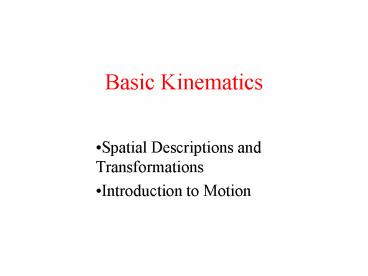Basic Kinematics - PowerPoint PPT Presentation
1 / 25
Title:
Basic Kinematics
Description:
Be able to transform between coordinate systems. Use frames and homogeneous ... mapping changes the description of a point from one coordinate system to another ... – PowerPoint PPT presentation
Number of Views:86
Avg rating:3.0/5.0
Title: Basic Kinematics
1
Basic Kinematics
- Spatial Descriptions and Transformations
- Introduction to Motion
2
Objectives of the Lecture
- Learn to represent position and orientation
- Be able to transform between coordinate systems.
- Use frames and homogeneous coordinates
Reference Craig, Introduction to Robotics,
Chapter 2. Handout Chapter 1
Almost any introductory book to robotics
3
Introduction
- Robot manipulation implies movement in space
- Coordinate systems are required for describing
position/movement - Objective describe rigid body motion
- Starting point there is a universe/ inertial/
stationary coordinate system, to which any other
coordinate system can be referred
4
The Descartes Connection
- Descartes invented what we now call Cartesian
coordinates, or the system by which we can graph
mathematical functions in two-or
three-dimensional space. - So, all of those problems you have been working
in algebra are his fault. - Descartes was lying on his bed watching a fly.
Slowly, it came to him that he could describe the
fly's position at any instant by just three
numbers. Those three numbers were along the
planes of the floor and two adjacent walls, what
we now call the x,y,z coordinate system. - So, all of those problems you have been working
in algebra are really the flys fault (kill that
fly)
5
Coordinate System in Robotics
Descartes invented what we now call Cartesian
coordinates, or the system by which we can graph
mathematical functions in two-or
three-dimensional space. So, all of those
problems you have been working in algebra are his
fault. Descartes was lying on his bed watching a
fly. Slowly, it came to him that he could
describe the fly's position at any instant by
just three numbers. Those three numbers were
along the planes of the floor and two adjacent
walls, what we now call the x,y,z coordinate
system. So, all of those problems you have been
working in algebra are really the flys fault
(kill that fly)
6
Three Problems with CS
- Given 2 CSs, how do we express one as a function
of the other? - Given a point in one CS, what are the points
coordinates on a second CS? - Apply an operation on a vector
7
Description of a Position
- point position vector
YA
8
Description of an Orientation
Often a point is not enough need orientation
- In the example, a description of B with
respect to A suffices to give orientation - Orientation System of
Coordinates - Directions of B XB, YB and ZB
- In A coord. system AXB, AYB and AZB
9
From A to B
We conclude
10
Rotation Matrix
- Stack three unit vectors to form Rotation Matrix
- describes B with respect to A
- Each vector in can be written as dot
product of pair of unit vectors cosine matrix - Rows of unit vectors of A with respect
to B - What is ? What is det( )?
- Position orientation Frame
11
Description of a Frame
- Frame set of four vectors giving position
orientation - Description of a frame position rotation
matrix - Ex.
- position frame with identity as rotation
- orientation frame with zero position
12
Mapping from frame 2 frame
Translated Frames
- If A has same orientation as B, then B
differs from A in a translation APBORG - AP BP APBORG
- Mapping change of description from one frame to
another. The vector APBORG defines the mapping.
13
Rotated Frames
Description of Rotation Rotation Matrix
14
Rotated Frame (cont.)
- The previous expression can be written as
- The rotation mapping changes the description of a
point from one coordinate system to another - The point does not change! only its description
15
Example (2D rotation)
?
16
General Frame Mapping
Replace by the more appealing equation
A
A row added here
A 1 added here
17
Homogeneous Coords
- Homogeneous coordinates embed 3D vectors into 4D
by adding a 1 - More generally, the transformation matrix T has
the form
18
Operators Translation, Rotation and General
Transformation
- Translation Operator
19
Translation Operator
- Translation Operator
- Only one coordinate frame, point moves
- Equivalent to mapping point to a 2nd frame
- Point Forward Frame Backwards
- How does TRANS look in homogeneous coordinates?
20
Operators (cont.)
- Rotational Operator
Rotation around axis
AP1
AP2
21
Rotation Operator
- Rotational Operator
- The rotation matrix can be seen as rotational
operator - Takes AP1 and rotates it to AP2R AP1
- AP2ROT(K, q)(AP2)
- Write ROT for a rotation around K
22
Operators (Cont.)
- Transformation Operators
- A transformation mapping can be viewed as a
transformation operator map a point to any other
in the same frame - Transform that rotates by R and translates by Q
is the same a transforming the frame by R Q
23
Compound Transformation
- If C is known relative to B, and B is known
relative to A. We want to transform P from C
to A - Write down the compound in homog. coords
24
Inverse Transform
- Write down the inverse transform in HCs
25
More on Rotations
- We saw that a rotation can be represented by a
rotation matrix - Matrix has 9 variables and 6 constraints
(which?) - Rotations are far from intuitive they do not
commute! - Rotation matrix can be parameterized in different
manners - Roll, pitch and yaw angles
- Euler Angles
- Others































